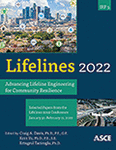Community Resiliency Infrastructure and Sustainability Protocol
Publication: Lifelines 2022
ABSTRACT
Engineers must above all else protect and advance the health, safety, and welfare of the public. Professional societies create codes and standards that guide development of the built environment to serve the public needs. Elected officials are, ultimately, responsible for the allocation of public funding to ensure the resilience and overall performance of new and existing infrastructure. This intersection of public policy and engineering is a place where engineers should take a more active role. This study outlines a process for public accounting using value analysis of the regional infrastructure, including benefit-cost analysis for new structures as well as existing infrastructure. CRISP, Community Resiliency Infrastructure Protocol, is founded on probabilistic estimates, stochastic analysis, and accepted discounting assumptions. The ASCE Infrastructure Resilience Division has initiated a project to further develop this concept. The goal is to create methodologies that can be utilized for decision-making, improving the resilience and sustainability for infrastructure systems and communities.
Get full access to this article
View all available purchase options and get full access to this chapter.
REFERENCES
ASCE. (2014). Flood Resistant Design and Construction. ASCE/SEI 24-14. Reston Virginia, 75 p.
ASCE. (2017). Minimum Design Loads for Buildings and Other Structures. ASCE/SEI Standard 7-16. Reston, Virginia, 889 p.
ASCE California. (2011). “Methodology for California Infrastructure Report Card,” Report Card for America’s Infrastructure. Accessed March 3, <http://www.ascecareportcard.org>.
Bonstrom, H., R. Corotis, and K. Porter. (2012). “Overcoming Public and Political Challenges for Natural Hazard Risk Investment Decisions,” Journal of Integrated Disaster Risk Management, 2(1), 1–23.
Corotis, R. B. (2002). “The Political Realities of Life Cycle Costing,” Bridge Maintenance, Safety and Management, J.R. Casas, D.M. Frangopol and A.S. Nowak, Editors, International Center for Numerical Methods in Engineering, 2002, Barcelona, Spain, CD Rom.
Corotis, R. (2010). “Political Issues for Sustainable Hazards Policy,” International Journal of Engineering under Uncertainty: Hazards, Assessment and Mitigation, 2(1), January-June 2010, 1–7.
Corotis, R. (2017). “Communicating Community Infrastructure Risks,” 12th International Conference on Structural Safety and Reliability, August, 2017, Vienna.
Corotis, R. (2018). “Planning for Community Resilience under Climate Uncertainty,” Interdisciplinary Issues Related to Climate Change and its Impacts, Colleen Murphy, Paolo Gardoni and Robert McKim, Eds., Springer, Cham, Switzerland.
Corotis, R. (2019). “Engineering’s Role in Policy Decision-Making for Natural Hazards and Community Resilience,” Proceedings, 2nd International Conference on Natural hazards and Infrastructure, Chania, Greece, June.
Davis, C. A. (2020). “Understanding Functionality and Operability for Infrastructure System Resilience,” ASCE Natural Hazards Review, 22(1), https://doi.org/10.1061/(ASCE)NH.1527-6996.0000431.
ISO. ISO 2394. (2015). General principles on reliability for Structures, March 1, International Standards Organization, Geneva, Switzerland, ISO 2394: 2015(E).
McClure, D. L., and Land Use Planning Committee Institute for Business and Home Safety. (2002). “Are We Planning Safer Communities?” Natural Hazards Observer, 26 (6): 1–3, Accessed June 4, 2021, <https://hazards.colorado.edu/uploads/observer/2002/july02/july02.pdf>.
Mileti, D. (1999). Disasters by Design, Joseph Henry Press, Washington, D.C.
Multi-Hazard Mitigation Council. (2019). Natural Hazard Mitigation Saves: 2019 Report. National Institute of Building Sciences. Washington, DC, 619 p. https://www.nibs.org/projects/natural-hazard-mitigation-saves-2019-report.
Multi-Hazard Mitigation Council. (2021). PDX Resilient Runway Benefit-Cost Analysis. National Institute of Building Sciences. Washington, DC, https://www.nibs.org/reports/portland-resilient-runway-benefit-cost-analysis.
Office of Management and Budget. (2003). Circular A-4. The White House, Washington DC.
OECD – International Transport Forum,. Round Table, 25-26, October 2007, Boston.
Scawthorn, C. R., K. A. Porter, and C. A. Davis. (2022). “Benefit-cost optimization of resilient lifeline networks.” ASCE Lifelines Conference 2021 2022, February 7-11, 2022, University of California Los Angeles (this conference).
Szanton, P. (2001). Not Well Advised, Authors Choice Press, Lincoln, Nebraska.
Vacheyroux, G., and R. Corotis. (2013). “Strategies of investment in the management of urban bridges: a life-cycle approach illustrated for Paris,” Structure and Infrastructure Engineering: Maintenance, Management, Life-Cycle Design and Performance, 9:11, 1080–1093.
Zhou, H., and T. Attard. (2014). “Simplified Anisotropic Plasticity Model for Analyzing the Postyield Behavior of Cold-Formed Sheet-Metal Shear Panel Structures.” J. Struct. Eng., https://doi.org/10.1061/(ASCE)ST.1943-541X.0001152, 04014185.
Information & Authors
Information
Published In
History
Published online: Nov 16, 2022
Authors
Metrics & Citations
Metrics
Citations
Download citation
If you have the appropriate software installed, you can download article citation data to the citation manager of your choice. Simply select your manager software from the list below and click Download.
